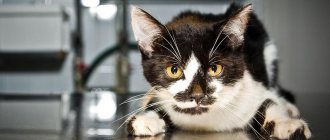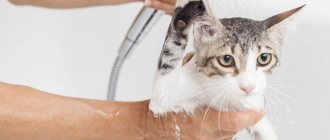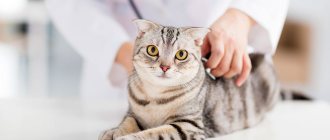One of the problems that purebred cats often face is polycystic kidney disease. The disease is inherited, seriously impairing the pet's quality of life. It is accompanied by painful sensations and provokes irreversible consequences for the entire animal’s body.
That is why, when the first signs of the disease appear, it is necessary to undergo a full examination at a veterinary clinic. Read on to find out what polycystic kidney disease is and whether this disease can be cured.
Read in this article:
Polycystic kidney disease - what is it? Causes of the disease Main symptoms Stages of polycystic disease: how does it develop? How do you know if your cat has PCOS? Treatment of the disease Complications Is it possible to cure polycystic kidney disease in cats? Disease prevention
Polycystic kidney disease - what is it?
Polycystic disease is a disease in which a large number of cavities filled with fluid (cysts) form in the kidneys. With this pathology, the part of the organ that is affected becomes a vesicular formation. Polycystic disease simultaneously affects both kidneys, disrupting their functions.
As a result, they cease to cope with their main task - filtering. Harmful components accumulate in the body, causing intoxication. Sooner or later, polycystic disease leads to kidney failure and other dangerous consequences.
Most often, polycystic disease manifests itself clearly between the ages of 3 and 10 years. In more than 90% of cases, it is diagnosed in 7-year-old cats. Until this age, the disease is not so noticeable, since the size of the kidney remains normal and does not cause suspicion. Often similar cysts can be detected not only in the kidneys, but also in other internal organs (for example, in the liver).
Diet and nutrition for cats with chronic renal failure
In addition to the main treatment, it is necessary to adjust the animal’s diet and switch to feeding special food.
When renal crisis or nephropathy is detected in cats, therapy is supplemented with nutritional correction. The animal must be fed with special dry food or homemade food. The pet's body must receive the required amount of nutrients every day. The following products are prohibited:
- animal fats;
- milk;
- liver;
- fish fat;
- porridge;
- flour products;
- marine fish;
- any caviar.
The question of what to feed a cat with kidney failure is especially acute. Along with food, the cat receives not only nutrients and vitamins, but also many microelements that are not fully absorbed by the body.
When kidney function is disrupted, these “extra” elements are not excreted along with the urine, but accumulate in the body: in the kidneys themselves, in the tissues of other organs, on the walls of blood vessels, and in the blood.
The goal of a therapeutic diet is to exclude from the animal’s diet everything that will serve as intoxication, while at the same time providing it with all the substances necessary for health.
There are several rules that will help reduce the load on the urinary system and maintain the health of your pet:
- It is necessary to reduce the intake of phosphorus into the body, which means completely eliminating fish (including caviar and fish oil).
- Avoid foods high in calcium: dairy and fermented milk products, eggs, cottage cheese, cheese.
- All fatty meats are contraindicated: pork, beef, rabbit, duck and goose. Only chicken and turkey meat (exclusively breast meat) are relatively safe for cats with kidney failure.
- Proteins and fats should enter the body to a minimum. It is better to reduce the share of meat to 10 - 20% of the total food.
- Porridge in any form, as well as bread and other flour products will also have to be excluded from the pet’s diet.
- It is necessary to increase the mass proportion of vegetables, especially cabbage and carrots.
- It is imperative to add alkalizing foods to your food to help maintain the acid-base balance. Chalk or special preparations can be used as such substances.
For cats suffering from kidney failure, a natural diet is not suitable because the list of approved foods is depressingly short and does not provide the cat with the necessary amount of essential substances.
No additional vitamins or dietary supplements are required with this diet. True, there are also contraindications: Renal cannot be prescribed to kittens under one year old, as well as to pregnant and lactating cats.
The minimum time during which an animal needs to be given this food is six months. And in case of chronic renal failure, veterinarians prescribe Renal as a dietary food for the rest of their life.
The danger of kidney failure, especially chronic, is that owners do not always realize the full danger of the illness that befalls their pet. With the slow progression of the disease, the animal may look quite alert, which creates the illusion that dieting and prevention of renal failure are no longer necessary.
Violation of dietary principles may not cause immediate deterioration. However, this will speed up intoxication and reduce the time that the furry pet could live next to its owners.
Since the changes that occur in the kidneys during chronic renal failure are, for the most part, irreversible, the most important goal of treatment is dietary support
After detoxification therapy, regulation of blood pressure and electrolyte balance, it is very important to reduce the protein and mineral load on the kidneys, since kidneys in chronic renal failure mainly cannot cope with the elimination of protein breakdown products - urea and creatinine
There are a number of medicated foods specifically designed for cats with chronic renal failure. In our practice, we use diets from such feed manufacturers as Royal Canin, Hill's, Purina, Eukanuba.
Causes of the disease
The only reason that can trigger the development of polycystic kidney disease is heredity. This is due to the fact that a specific gene (PKD-1) responsible for protein synthesis mutates. It is transmitted to the kitten from its mother or father and is present in its body from birth. All this leads to the formation of a gradually growing cyst.
Cat breeds that are at risk:
- Persian,
- British,
- Himalayan,
- exotic shorthair.
Main features
Polycystic disease is a slowly progressive disease. Numerous, but small cysts are present already at the birth of a kitten. Gradually they enlarge, replacing healthy kidney tissue and putting pressure on the surrounding areas. Up to a certain point, this disease is asymptomatic, then the main symptoms begin to appear.
On average, the size of cysts ranges from 0.5 to 1 cm. In rare cases, they exceed 1 cm.
Symptoms indicating polycystic kidney disease in an animal:
- loss of appetite and complete refusal to feed,
- lethargy,
- apathetic state
- strong thirst
- sudden weight loss,
- excessive urination,
- vomit.
Cats with polycystic disease have eye lesions. The size of the pupils changes, visual acuity decreases. It is possible that a bacterial infection may occur that affects the genitourinary system. At the same time, body temperature rises, pyelonephritis or glomerulonephritis develops.
Stages of polycystic disease: how does it develop?
First . The general condition of the animal does not cause concern. Signs of pathology are completely absent. The only thing that can be noticed is pain in the area where the kidneys are located. The weight of kittens suffering from polycystic disease lags behind the established indicators. There are deviations in the composition of urine, but it is impossible to detect them at home.
Second . Pain in the kidney area is much more pronounced than in the first stage. The cat drinks a lot of water and goes to the litter box often. At the same time, appetite is reduced. The cat hardly eats, so it looks exhausted. The animal moves little and does not play. Vomiting may occur periodically. During the examination, abnormalities will be detected not only in the composition of urine, but also in blood.
Third . The main feature of this stage is pronounced signs of chronic renal failure (CRF) caused by polycystic disease. Now changes in urine can be noticed not only by a specialist, but also by the cat owner. It may contain blood and cloudy discharge. The pet's condition worsens, he does not respond to stimuli, and often experiences convulsions.
How do you know if your cat has PCOS?
The only way to determine whether your pet suffers from polycystic disease is to contact a veterinary clinic in Moscow. Here a thorough diagnosis of the animal’s condition will be carried out, on the basis of which a diagnosis will be made.
The initial examination includes identifying clinical signs of the disease, laboratory testing of urine and palpation. To make an accurate diagnosis, a biopsy is prescribed. It shows how dangerous cysts are to the health and life of your pet.
One of the methods used during diagnosis is ultrasound examination (US). It allows you to see the tumor and assess the condition of the kidneys (the ratio of healthy and damaged tissue). At the last stage, polycystic disease can only be detected using radiography.
Diagnostics in a veterinary clinic
The diagnostic examination begins with inspection and palpation. The veterinarian looks for lumps by palpating the cat's abdomen.
Idiopathic cystitis in cats: symptoms and treatment
Veterinarian appointment
A preliminary diagnosis is made based on the owner’s complaints, symptoms, and pet’s behavior. Additional examination of the fundus shows characteristic changes in the blood vessels of the organs of vision and is a manifestation of the developed pathology.
Laboratory diagnostic methods
Confirmation of the disease is carried out by submitting:
- urine analysis. Changes in urine (proteinuria, microhematuria) begin before visible blood particles appear in it;
- general and biochemical blood analysis. They are used to determine changes in creatinine, leukocytes, erythrocytes, and ESR;
- taking a swab from the oral cavity. Allows you to determine polycystic disease with 98% confidence.
Note! Collection of material from the oral cavity can be carried out in a 1-2 month old kitten. The procedure allows you to identify polycystic disease before the appearance of the main clinical symptoms and begin symptomatic treatment
How is ultrasound examination performed?
Kidney ultrasound is one of the most informative and reliable methods for confirming the presence of cysts in the kidneys. The procedure is carried out according to the following algorithm:
- The hair from the peritoneal area is shaved.
- The kidneys are examined using a sensor.
- The formed cavities appear on the monitor as darkened dense areas. The size of the cysts is calculated from them.
Ultrasound examination is recommended for babies over 10 months. An earlier age will not allow you to accurately determine polycystic changes due to their small volumes.
For your information! In 10-month-old cats, cavities in the kidneys are found in 95% of cases (with a hereditary predisposition).
Treatment of the disease
The treatment program is compiled individually. It depends on the condition of the cat, the size of the cystic blisters and the stage of the disease. If the cysts are small, the veterinarian will recommend removing the fluid using a special needle. This procedure is performed regularly and can reduce the symptoms of developing kidney failure.
Other treatments for polycystic disease:
- Diet . It is necessary to give your cat special wet food (it has appropriate marks on the packaging) with a low phosphorus content. This is due to the fact that phosphorus leads to the development of signs of kidney failure. Additionally, complexes with vitamin D are prescribed.
- Detoxification . To cleanse the animal's body of toxins, rehydration solutions are prescribed. They are administered parenterally, i.e. without the participation of the cat’s gastrointestinal tract. This ensures high bioavailability of the components and their rapid absorption by the body.
- Restoring blood pressure (BP) . At all stages of the development of polycystic kidney disease, blood pressure disturbances are observed. To eliminate this symptom, special medications are prescribed. To maintain the prescribed dosage, you must use a tablet knife.
- Taking gastroprotectors . They are intended to eliminate attacks of nausea that occur with polycystic kidney disease in cats. Gastroprotectors correctly selected by a veterinarian prevent the occurrence of stomach ulcers. Additionally, medications are prescribed that reduce the formation of gastric juice.
- Taking antibiotics . Antibiotic drugs are prescribed by a veterinarian if secondary microflora is detected during diagnosis. They prevent its further development, and also reduce the rate of manifestation of chronic renal failure (CRF).
There are no specific treatments for polycystic disease. Diet therapy, taking gastroprotectors and other measures listed are aimed at supportive symptomatic therapy. It eliminates and prevents intoxication of the animal's body caused by kidney failure.
Cats diagnosed with polycystic disease require regular examinations (at least once a year). These include ultrasound, as well as blood and urine tests. If your pet’s condition with polycystic disease worsens sharply, you should contact a veterinarian as soon as possible.
General information about the disease
Polycystic disease is a serious disorder that affects a kitten’s kidneys from a very early age. A characteristic feature of this disease is the appearance of small cysts filled with fluid in the kidney tissues. Gradually, the tumors grow, thereby replacing healthy cells. During the course of the disease, the cat’s body adapts to problems in the functioning of the infected organs, so signs of polycystic disease may be absent for a long time.
The following cat breeds are most often affected by polycystic disease:
- exotic shorthair;
- Persian;
- Himalayan;
- Scottish lop-eared;
- mixed breeds of the above breeds.
The complexity of the disease lies in the fact that the process of kidney damage by cysts is irreversible and it is constantly progressing. The size of the formations increases throughout the animal's life, leading to the development of renal failure. Although polycystic disease cannot be cured completely, therapeutic methods can slow down its progression if detected early.
Lack of treatment contributes to the development of complications as a result of kidney damage from cystic formations.
Complications of polycystic disease:
- renal failure;
- intoxication of the body;
- infection of the body by bacteria;
- sepsis;
- transformation of cysts into malignant neoplasms;
- death.
Despite the fact that polycystic disease most often affects purebred cats, any cat can suffer from this disease, regardless of breed, age and physiological characteristics.
Complications
If you do not seek veterinary help or neglect treatment prescribed by a specialist, your pet’s condition will rapidly deteriorate. This is due to the fact that the cysts increase in size, gradually filling the entire kidney area and having a negative effect on the soft tissue of other internal organs.
Possible complications include:
- chronic renal failure (CRF),
- intoxication,
- formation of malignant tumors,
- pyelonephritis,
- glomerulonephritis,
- sepsis.
Symptoms and diagnosis
What are the symptoms of the disease in the presence of pathologies? It is very difficult to determine the initial stages of the disease, one might say impossible. When the cysts greatly increase in size, they cause pain, the abdominal cavity becomes larger, and then the animal begins to suffer and the owner clearly notices this in the behavior of the furry friend. But when simple papation reveals many cysts, it is often too late and the only way out is to remove the kidneys completely.
Polycystic disease does not show painful reactions during the growth of cysts. You can sometimes notice the presence of blood in the urine of a sick animal - hematuria. But it does not always mean the presence of this particular disease in the cat’s body. After all, other unpleasant moments are associated with this phenomenon - blood parasitic diseases or leptospirosis. Due to the absence of pain syndromes in a cat’s behavior, it is difficult to recognize kidney disease.
Symptoms of polycystic disease:
- The pet refuses to eat;
- Feels depressed and painful;
- Drinks a lot of water;
- Loses weight;
- He feels sick and vomits;
- Urinates frequently.
Based on test results, veterinary specialists can sometimes recognize the disease and make an accurate diagnosis. To confirm this, a biopsy is prescribed, based on the results of which the nature and degree of danger of the formations can be determined. It is also important to do an ultrasound of the kidneys in time, where not only the cystic accumulation is visually visible, but also how affected the organs are.
After the biopsy is done, it is necessary to check the seeding on the nutrient medium. Thanks to this analysis, it is determined whether a secondary bacterial infection is possible in order to promptly prescribe the necessary antibacterial agents that will directly have a positive effect on the diseased organ.
The presence of arterial hypertension or high blood pressure in a sick cat is not obvious, but still an indicator of problems with the excretory organs. Remember that cystosis can degenerate into a malignant tumor, and therefore a biopsy is a mandatory solution to subsequent problems.










